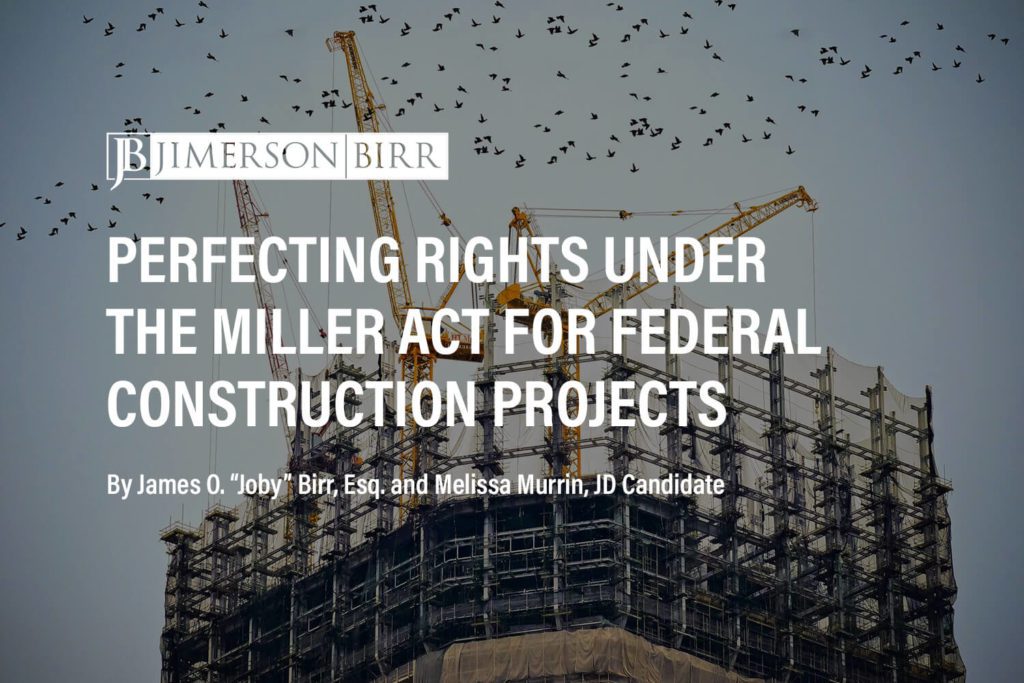Contractors cannot file mechanic’s liens on public construction projects, such as work on military bases, courthouses, or government owned buildings. Instead, the Federal Miller Act, 40 U.S.C. § 3131-3134, fills in this gap by protecting certain levels of subcontractors and material suppliers from general contractors who fail to pay them on federal construction projects. The Miller Act requires that before any contract of more than $100,000 is awarded for a construction project on a public building or public work of the federal government, the general contractor must furnish a payment bond and a performance bond.

Who Can File a Miller Act Claim
The Miller Act only applies to federal construction projects; it does not apply to commercial, private, or state construction projects. If the federal government owns or controls the underlying project site, the Miller Act will apply.
The next thing to consider is whether the subcontractor or material supplier is protected by the Miller Act. The Miller Act protects “all persons supplying labor and material in carrying out the work provided for in the contract.” 40 U.S.C. § 3131(b)(2). Although “parties” protected under the Miller Act is defined broadly, they are limited to:
- first-tier subcontractors, i.e., contracted directly with the general contractors;
- second-tier subcontractors, i.e., contracted directly with a first-tier subcontractor;
- first-tier material suppliers, i.e., contracted directly with general contractor; and
- second-tier material suppliers, i.e., contracted directly with a first-tier material supplier.
The Miller Act does not provide protection to general contractors, or lower tier subcontractors and material suppliers. Clifford F. MacEvoy Co. v. U.S. for Use & Benefit of Calvin Tomkins Co., 322 U.S. 102 (1944).
How to Bring a Miller Act Claim
All eligible subcontractors and material suppliers must wait 90-days after the last day of furnishing labor or materials before they can bring a civil action against the payment bond. Second-tier subcontractors and material suppliers must provide written notice to the general contractor during this 90-day period before they can file a Miller Act claim. Although it is not mandatory for first-tier subcontractors and material suppliers to provide notice to the general contractor, it is good practice to do so. The notice must:
- be in writing. 40 U.S.C. § 3133(b)(2);
- state with substantial accuracy the amount claimed;
- name the party to whom the material was furnished or supplied, or for whom the labor was done or performed; and
- be delivered to the general contractor by any means that provides written, third-party verification of delivery at any place the general contractor maintains an office, conducts business, or at the general contractor’s residence; or in any manner in which the United States marshal of the district in which the public improvement is situated by law may serve summons.
The general contractor has a duty to forward notice of the bond claim to the bonding/surety company. Claimants must ensure that the surety does in fact have a copy of the notice. Therefore, although not required, it is good practice to forward a copy of the notice to both the general contractor and the surety.
When the 90-day waiting period passes and payment in full has not been made, the next step is to bring a lawsuit to enforce the Miller Act claim. The bond claimant has one year from the last day of furnishing labor or materials to bring a civil action on the Miller Act payment bond. 40 U.S.C. § 3133(b)(4). If a lawsuit is not filed in a timely manner, the claim will fail. The Miller Act lawsuit must be brought in the name of the United States and filed in the federal district court where the project is located. 40 U.S.C. § 3133(b)(3).
Recoverable Damages
A Miller Act payment bond covers labor or material supplied or furnished in the prosecution of the work provided for in the contract for which the bond was required to be furnished. 40 U.S.C. § 3131(b)(2). Recoverable damages may also include the following:
- the cost of equipment rented to perform work. S. for Use & Benefit of Malpass Const. Co. v. Scotland Concrete Co., 294 F. Supp. 1299 (E.D.N.C. 1968);
- the cost of freight and transportation of materials.S. for Use & Benefit of Mid Seven Transp. v. Blinderman Const. Co., 735 F. Supp. 272 (N.D. Ill. 1990);
- oil and gas for use on the construction project. S. for Use of Tom P. McDermott, Inc. v. Woods Const. Co., 224 F. Supp. 406 (N.D. Okla. 1963);
- material not actually used, but claimant had a good faith belief that the materials would be used. S. for Use & Benefit of Krupp Steel Prod., Inc. v. Aetna Ins. Co., 831 F.2d 978 (11th Cir. 1987);
- delay costs, so long as the claimant did not contribute to the delay. S. for Use & Benefit of Lincoln Elec. Prod. Co. v. Greene Elec. Serv. of Long Island, Inc., 379 F. 2d 207 (2d Cir. 1967);
- prejudgement interest, so long as the contract and state law permits recovery of prejudgment interest. S. for Use and Benefit of WFI Georgia, Inc. v. Gray Ins. Co., 701 F. Supp. 2d 1320 (N.D. Ga. 2010).
Recovery of Attorney’s Fees
There is no specific provision in the Miller Act that expressly allows for the recovery of attorney’s fees. However, attorney fees may be recoverable if the claimant is entitled to attorney’s fees pursuant to the contract. U.S. ex rel. Maddux Supply Co. v. St. Paul Fire & Marine Ins. Co., 86 F. 3d 332, 336 (4th Cir. 1996).
Takeaways
Since persons or businesses are not able to record mechanic’s liens on federal construction projects, it is important to know how to ensure payment for work or materials. Claimants must be vigilant in providing the requisite notice to perfect their Miller Act payment bond claim, as well as filing their lawsuit within one year of the last day of furnishing labor or materials.
Authors:
- James O. “Joby” Birr, III, Esq.
- Melissa Murrin, JD Candidate 2021

